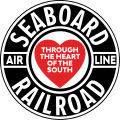Brooksville to Waldo
At its greatest extent, the Brooksville Subdivision extended as far north as Waldo. Track from Waldo to Archer (which continued southwest to Cedar Key) was built in 1861 by the Florida Railroad. The Florida Railroad later became part of the Florida Central and Peninsular Railroad (FC&P) network. In 1890, the FC&P built track from Archer south to Early Bird as a branch track. The Seaboard Air Line bought the FC&P network in 1900, with track from Waldo to Cedar Key becoming their Cedar Key Branch. [8] In 1911, track was extended south of Early Bird to Inverness. The extension from Early Bird to Inverness ran closely parallel the Atlantic Coast Line Railroad's High Springs–Lakeland Line.
In 1925, the Brooksville and Inverness Railway, a Seaboard subsidiary, was built connecting Inverness with the former Tampa Northern Railroad in Brooksville. This would create an additional freight route from northern Florida to the Tampa Bay region as an alternative to the Seaboard main line. [9] Around the same time, track from Inverness to Waldo was upgraded with heavier rail, and the Seaboard main line was double-tracked from Starke (just north of Waldo) north to Baldwin which further increased capacity. [10] [11]
When complete in 1925, the line was designated as the Brooksville Subdivision from Waldo to Sulphur Springs and the remaining track from Archer to Cedar Key was designated as the Cedar Key Subdivision. By the end of 1926, the Seaboard Air Line was running at least three freight trains a day to Tampa on the Brooksville Subdivision. This included a daily mail train, the Manatee River Special freight train, and an additional through freight train. An additional local freight train also ran the line six days a week. Local passenger service between Waldo and Cedar Key was also running the Brooksville Subdivision north of Archer at the time. [12]
The Cedar Key Subdivision was abandoned in 1932. [13] By 1940, the Seaboard was running a daily through freight train round-trip on the line. [14]
Later years
The Seaboard Air Line became the Seaboard Coast Line Railroad in 1967 after merging with their former rival, the Atlantic Coast Line Railroad. The line initially remained intact after the merger. [15] The Seaboard Coast Line abandoned the Brooksville Subdivision between Waldo and Brooksville in the 1970s (which nearly restored the Tampa Northern Railroad's original terminus ironically) as it was largely redundant as a through route due to the Atlantic Coast Line Railroad's nearly parallel route as well as its own main line to Tampa. The line now ends near the Broco Quarry just north of Brooksville. Despite the abandonment, the line's SR mileposts numbers remain as they did when the full line was intact. [3]
In 1980, the Seaboard Coast Line's parent company merged with the Chessie System, creating the CSX Corporation. The CSX Corporation initially operated the Chessie and Seaboard Systems separately until 1986, when they were merged into CSX Transportation.




